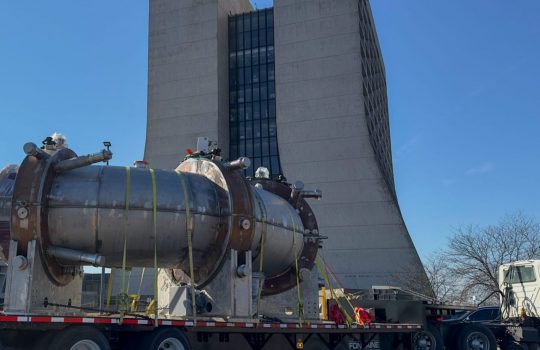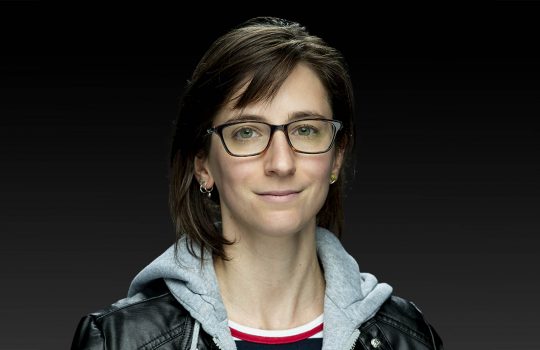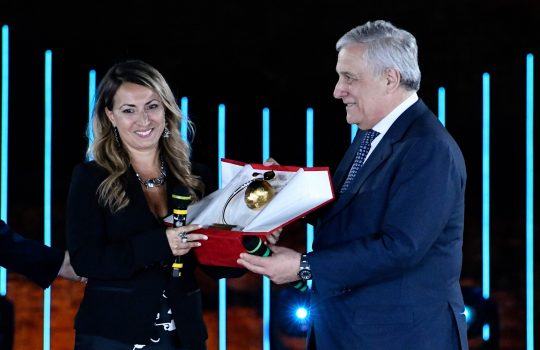
URA Executive Director Marta Cehelsky, right, presents Jacob Todd with his award. Photo: Reidar Hahn
Jacob Todd of the University of Cincinnati is the recipient of this year’s URA Graduate Thesis Award for his work on the Fermilab MINOS and MINOS+ neutrino experiments.
The Universities Research Association presents the award annually for outstanding work by a graduate student working at or in collaboration with Fermilab.
“Jacob’s thesis has something for everyone,” said Fermilab scientist Chris Stoughton, chair of the URA Graduate Thesis Award Committee. “He explains the motivations for modern neutrino research that will delight all interested science buffs.”
Especially if that science buff enjoys approaching data from a new perspective.
Todd details a method for analyzing data from neutrino experiments in a way that removes bias present in traditional methods. It’s the first time that the method has been applied for long-baseline neutrino experiments — experiments in which two neutrino detectors are separated by a great distance.
Neutrinos are inscrutable particles known for changing from one type into another as they travel. Particle physicists call these types “flavors.”
Researchers on MINOS and MINOS+ compared data from two detectors 700 miles apart to study these change patterns and to smoke out a new flavor of particle hinted at but never seen, the sterile neutrino.
“The URA Thesis Award shows just how creative, adaptive, and imaginative young scientists working with Fermilab can be,” said URA Executive Director Marta Cehelsky. “Jacob Todd’s excellent thesis is a stellar example of the great work being done by young scientists and the role of Fermilab in nurturing young talent.”
Typically, scientists measure the neutrinos that appear in the first detector, called the near detector because of its proximity to the neutrino source (Fermilab’s accelerators in the case of MINOS and MINOS+). Based on those measurements, they make predictions about what they expect to see in the second, far detector. If the far-detector data doesn’t align with the expectation, scientists dig into the discrepancy, which could be a sign of new physics waiting to be discovered.
Todd’s data analysis removes the bias that comes from setting the near-detector data as the baseline. He demonstrates how scientists can look for unexpected discrepancies that appear not only in the far detector, but in the near detector as well. The idea is to be as blind as possible to investigative bias from both detectors.
The method is especially useful when searching for sterile neutrinos. Looking at data in both detectors simultaneously enables scientists to see the flavor-changing behavior in two directions, helping them better identify the type of shape-shifting that happens in that miles-wide gap, whether it’s a neutrino that changes into one of the three known flavors or into the sterile flavor.
“I’m honored to receive this award, and I’m glad people are finding value in my thesis. It was a long time in the works,” Todd said. “I was one of the final analyzers to go through MINOS and MINOS+ data, so I was able to do more things with it than most researchers were able to. This analysis was my baby from beginning to end, so it was a unique experience.”
MINOS started in 2005. With a ramp up in neutrino energy, MINOS entered a new stage as MINOS+ in 2013. The experiment closed in 2016.
“Jacob gives invaluable details of MINOS that benefit his collaborators,” Stoughton said. “He also describes innovative analysis techniques for combining observations from near and far detectors for future neutrino projects.”
Other long-baseline neutrino experiments use or plan to adopt Todd’s analysis technique, too. They include Fermilab’s NOvA, the Japanese T2K, and the upcoming international Deep Underground Neutrino Experiment, hosted by Fermilab.



